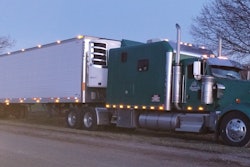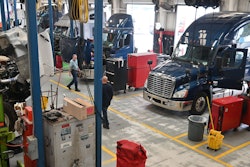Volvo claims its all-new Volvo VNL is 90% new and 10% more efficient. In his overview and quick spin in the new truck, CCJ Editor Jason Cannon pours over every detail that makes this semi-truck better than the prior generation VNL. At first glance, you'll notice obvious new features such as the new grille and air intake system, but hidden inside is a completely redesigned interior, advanced driver safety features, and a stronger D13 engine. The all-new Volvo VNL will enter production in late 2024.
In this video
00:00 - 90% New & 10% More Efficient
00:45 - Front of the Truck, Aerodynamics, and Air Management
02:36 - Interior
03:36 - Safety Features
04:18 - Engine and Efficiency
05:20 - Model Types and Customization
Hey everybody, CCJ editor Jason Cannon here. Join me for a closer look at Volvo’s all-new VNL – a truck that is so new that I was among the first people in the world to get behind the steering wheel.
When the VN Series arrived stateside in the mid-1990s, it was a European platform tailored for North American needs, but all that is changing.
For the 2024 redesign of its VNL – a six year developmental process – Volvo went with a blank slate approach. No stone was left unturned and no legacy was too sacred to re-mold. The end result is a truck that Volvo claims in 90% new and 10% more efficient and for you math majors out there, that equals 100% cool.
Let’s start at the front. I didn’t want to like the new grille because I thought the honeycomb pattern was unique. But I can’t do it. I love it. And it’s huge; a key part of aerodynamic and air management system that does three things: Cut through the wind, stay connected to the wind and move the wind, using it to the tractor's advantage. The front hood curvature and extra low ground effects cut through the wind. The sloped windshield and wedge-shaped cab keeps the cab connected to the air, creating a continuous draft alongside the tractor. The aerodynamic roofline and improved under flow moves the wind and hands it off to the trailer.
Do you see that hood scoop? Yes, it’s functional and it and the other air inlets create kind of a synchronized mini-tornado that keeps the engine cool, limiting how many times the cooling fan comes on, while also keeping air attached to the cab.
Duane Tegels, Product Marketing Manager at Volvo Trucks North America, explains.
Inside you’ll find a new versatile bunk styled after a Murphy bed. The rear control panel is consolidated and gives the driver to control practically every function from the bunk area. It can also be synched with the control panel in the front driver display.
VNL also gets an upgraded suspension system designed to keep the driver more comfortable and supported. A new parabolic spring aids stability, while new engine mount bushings keep vibration from the road from coming into the steering wheel.
Volvo’s new VNL will serve as the launchpad for all future powertrain innovations, including battery electric, hydrogen, autonomous and a host of other solutions. And as such, the truck gets a 24-volt electrical system. All that new tech is going to need a lot of power. 24 volt architecture improves the life of all electrical components, reducing battery failure rate, facilitating quicker diagnostics and repair, and a truck auto start feature will start the truck once a low battery is detected.
And, of course, this is a Volvo, so safety is at the forefront. Standard in every truck are Driver Alert Support; Basic Traction Control Support; Electronic Stability; Rollover protection actions; electronic parking brake and alarm; E-call; Pre-Trip Assist; driver airbag; back-up alarm; forward collision warning; lane departure warning; automatic emergency braking (AEB); adaptive cruise control with stop and go; forward pedestrian detection with AEB and stop and go.
E-call is an industry-first feature that alerts 911 when sensors detect a rollover or the airbag deploys.
The new D13 gets a horsepower rating bump up to 500 and 1950 ft-lb torque. Volvo’s six-wave piston will get a seventh wave which provides further directional control of the air and fuel mixture to create even more efficient combustion. The piston height was also decreased and paired with a longer connecting rod to minimize cylinder sidewall pressure, thereby decreasing friction and improving overall performance. The longer piston rod and slightly smaller piston allowed for the integration of a variable displacement oil pump, optimizing oil pressure regulation while minimizing parasitic losses. To minimize heat loss and increase efficiency, complete insulation was added to both the turbocharger and the turbo compounding unit. Internally, the turbo compounding unit refinements include a smaller compressor and turbine wheel, a strategic improvement that enables the system to recover surplus energy more effectively and convert it into usable power.
The units I were able to drive were pre-production, and I only was able to log about 6 miles. I expect to get more in-depth seat time later this year as the new VNL enters production.
The all-new Volvo VNL is packaged into four exterior and interior trim levels — Core, Edge, Edge Black and Ultimate — and six cab configurations: VNL 300 Day Cab; VNL 440 42-inch Mid-Roof Sleeper; VNL 640 62-inch Mid-Roof Sleeper; VNL 660 62-inch Full-Height Sleeper; VNL 840 74-inch Mid-Roof Sleeper; and VNL 860 74-inch Full-Height Sleeper.











